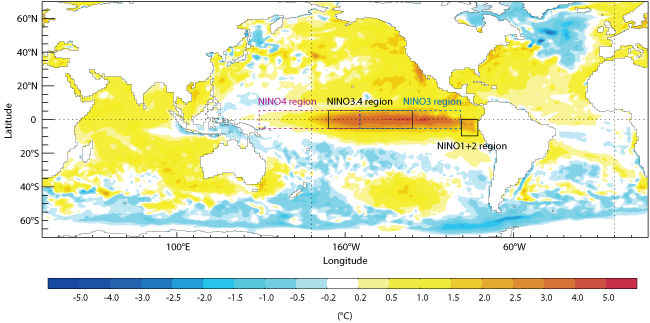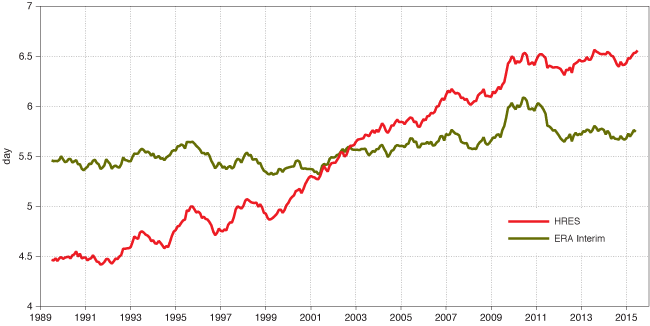

Once a year, on 23 March, the global meteorological community celebrates World Meteorological Day, which started in 1961 to mark the creation of a UN body specialising exclusively in meteorology in 1950.
Establishing the World Meteorological Organization (WMO) was no small achievement in its own right, and one which is unequivocally proving its critical value, as year on year extreme weather events continue to hit the world.
For us at ECMWF, proud members of the WMO community and enthusiastic partners in many of its endeavours, World Meteorological Day is an excellent opportunity to revisit the past twelve months and take stock of what has been achieved and where the science is taking our community.
Professor Erland Källén, ECMWF’s Director of Research, looks at the key moments that have marked the past twelve months at ECMWF.
Working in collaboration with its Member States, ECMWF provides weather forecasts to the global community on medium- and extended-range timescales. By doing so, ECMWF contributes to ensuring that society is better prepared for the increasing frequency of hot spells, droughts and heavy rain events, the main themes of World Meteorological Day 2016.
A notable example of such extreme weather in 2015 was the record El Niño event. The seasonal-range forecasts from ECMWF clearly indicated the increased likelihood of a record El Niño event as early as March 2015. As we came closer to the November peak in Pacific Ocean surface water temperatures, forecasts became more precise and the advanced warning provided earlier in the year proved to be correct. They also proved helpful, notably in Peru, where the Red Cross, using ECMWF’s early forecasts indicating the potential for an exceptional El Niño event, made flood preparedness in this region a priority.
Over the past several months, researchers at the University of Reading, the University of Oxford and ECMWF have been working with the Red Cross/Red Crescent Climate Centre (RCCC), the Peruvian and German Red Cross Societies, and the Servicio Nacional de Meteorología e Hidrología del Peru (SENAMHI) to analyse the links between El Niño and flooding in Peru, and work towards setting thresholds for action.

Average sea-surface temperature (SST) anomalies in November 2015, when the El Niño event peaked in the NINO3.4 region. The chart shows SST anomalies compared to the 1981–2009 average.
Another significant event was the heat wave that affected northern Europe in June, which ECMWF predicted a few weeks in advance. ECMWF also predicted several intense precipitation events in Europe in the medium range (3–10 days ahead), highlighting the great value of forecasts in this range.
Very recently, on 8 March 2016, the ECMWF forecast system underwent a substantial upgrade in resolution, resulting in a further improvement in forecast quality. The range of skilful predictions has been increased by up to half a day and the assimilation part of the system is handling satellite data in a much better way. This increases the accuracy of the starting point for the forecasts, a requirement for increasing forecast skill.
To achieve these results, ECMWF is very dependent on international collaboration, and the past twelve months have once again confirmed this. Observations of weather parameters were provided by the global observing system, co-ordinated by WMO. Satellites from agencies around the world provided a continuous stream of data that was ingested into the ECMWF data assimilation system. Without this data sharing, modern numerical weather prediction would be impossible.
The collaborative aspect of this effort does not stop here, and international cooperation in research, modelling developments and an open exchange of ideas and results have again been key to ECMWF’s activities.
The past twelve months have also highlighted the links between weather and climate modelling. The investments made in weather prediction models also benefit climate research as the physical processes underlying climate simulations and predictions are the same as those found in weather prediction models.
The weather predictions can be checked against reality every day, and the reliability of climate projections is dependent on the accuracy of weather forecasts. For climate change monitoring and research, reanalyses provide homogenous climate datasets. Reanalyses of historical climate observations are produced by ingesting historical data into modern assimilation and prediction models.
The past twelve months also saw ECMWF celebrate its 40th anniversary, marking forty years of collaboration in weather prediction science and operational forecast production.
A seven-day forecast today is about as accurate as a three-day weather prediction was in the mid-1970s. Scientific advances, increased computing power and an improved observing system have all contributed to this skill revolution.

Growing forecast range. The chart shows the lead time at which the anomaly correlation of ECMWF's high-resolution forecasts (HRES) of 500 hPa geopotential height at 00 and 12 UTC in the northern hemisphere extra-tropics reaches 80%. It shows a sustained increase in skilful forecast range from 4.5 to 6.5 days over the last 25 years. For reference, the same skill measure is also shown for ERA Interim forecasts, produced using an unchanged forecasting model corresponding to the operational model around the year 2003. The difference between the two indicates the effective increase in skill disregarding flow-dependent variations.
Future developments hold the promise of further improvements. It should be possible to foresee severe weather events, which today are only predictable about a week ahead, up to two weeks in advance. Weather regime changes, leading to heat spells and droughts as well as flooding and cold spells, can potentially be predicted up to a month ahead.
To reach these goals, the global meteorological community must continue to invest in improved observing systems and scientific advances. Both areas require people: scientists developing new prediction methods and engineers designing and launching satellites for new observation sensors. All this can only happen through continued global collaboration under the WMO framework, including a free exchange of scientific ideas and observation information.
The people needed to deliver the future vision for more accurate weather predictions will come from all areas of the globe. WMO sponsorship of Fellows is one important mechanism for this. Another is investments in scientific collaborative efforts that can attract the best talent available to tackle the challenges in climate change and weather prediction. Let World Meteorological Day 2016 be another opportunity to reiterate the fundamental role played by WMO as the international voice of meteorology.

Erland Källén is ECMWF's Director of Research.
